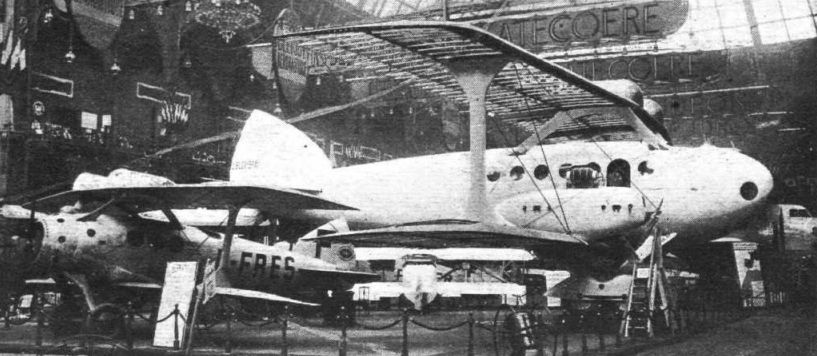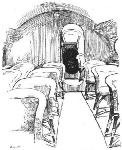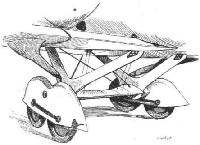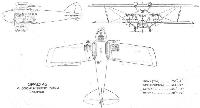
Flight, November 1921
The Paris Aero Show - 1921
BLERIOT-AERONAUTIQUE
3, Quai du Marechal Gallieni, Suresnes
THERE are not many machine at the Paris Salon this year, which one would stop and look at twice. The majority are very ordinary straightforward pieces of design, with here and there some frankly bad ones. To neither of these categories can the Spad-Herbemont 45 be said to belong. It is certainly not ordinary, and nobody would probably care to say that it is bad. M. Herbemont's record as a designer is such that his work is always entitled to a respectful consideration. The "Mammouth" exhibited in 1919 was about as poor a piece of design as it was possible to imagine, but no one who saw that machine could imagine for a moment that Herbemont had had anything to do with its design. That he did have something to do with so altering it that, by the aid of Casale's skill as a pilot, it was possible to coax it up to about 3,000 metres, is now fairly well-known, but it should be made clear that originally the machine was not a Herbemont. Indeed to anyone at all familiar with, his work, it was obvious that Herbemont would never have committed such an indiscretion.
However, to return to the present machine. The parentage of the 45 is obvious. It has Herbemont written bold in all its lines - even to the single I-strut on each side. And this in spite of the fact that the machine is a four-engined passenger carrier, with seating accommodation for 17 passengers plus a pilot, a navigator, and an engineer, bringing the total up to 20.
The fuselage is of the monocoque type, and a very beautiful piece of work. The extreme nose-piece of another fuselage is also exhibited, and from this one can obtain some idea of the construction. It appears that the fuselage is built-up of three laminations, of which the central one is longitudinal, the inner and outer forming an angle with it. The strips used are quite narrow, at any rate in the nose where the curves are fairly sharp. Here the strips appear to be only about 1 1/2 in. wide. Several longitudinal members run from nose to stern, and into these the ends of the relatively short strips are housed, much after the fashion of the planking of a flying-boat in the keel and chines. The finished result is a very neat, boat-built body of good lines and, one believes, great strength. Strangely enough, the engine nacelles are of similar construction, and not of metal sheet, as might have been expected.
The cabin is roomy, and the seating accommodation is somewhat unusual, inasmuch as along one side of the cabin, there are two rows of seats, whereas on the other (port) there is only one row. Each of these rows comprises four seats, and against the forward bulkhead of the cabin there are another three, two side by side on the port side and one on the starboard, these three seats facing aft. Thus, the main cabin accommodates 15 passengers. Aft of the cabin is a lavatory on the starboard side, entrance to which is through a door in a longitudinal partition. On the port side, there is a small compartment, which has an open cockpit in its roof. Immediately under this cockpit is a seat, while against the port wall, placed at floor level, is yet another seat. These bring the total passenger accommodation up to 17.
The pilot's cockpit is in front and on a higher level than the cabin, its floor being about two feet higher than that of the latter. A doorway gives access from the cabin to the pilot's cockpit, but as there is no provision made for a door one imagines that the cabin may be found somewhat draughty. The pilot sits on the port side, and on his right is a fairly large space which will, presumably, be occupied by the engineer. This cockpit is partly open forward so as to give access to the extreme nose of the machine, where there is a roughly hemispherical space for the navigator. This "chart room" is fitted up with wireless, maps, navigation instruments, etc., and has an open cockpit in its roof. The navigator, and also to a smaller extent the pilot, can look forward and downward through three circular windows in the extreme nose of the fuselage, so that for ascertaining drift, etc., the navigator need not expose his head to the wind. Altogether the cabin appears well thought-out. There is a trap door in the floor, leading to the "basement" below, from which another door leads to the lower plane. Corresponding to this door is one in the inner wall of each engine nacelle, obviously for the engineer to crawl through so as to get at his engines. As exhibited, there is no provision on the wing for keeping the engineer from being blown into space, but one understands that it is intended to fit some form of guide rail with netting.
The engines - four Hispano-Suizas - are placed on the wings tandem fashion. This is the feature one likes least of all on this machine. Past experience with tandem airscrews has not been such as to give any cause for optimism as regards efficiency, and we are quite certain that M. Herbemont would have been better advised to use two engines of greater power. He may have been influenced by the lack of French engines, suitable for the purpose, and possibly also by the somewhat problematical advantages of splitting the power up into four units, so that if one engine fails, the power is reduced by one-fourth only instead of by one-half. It is doubtful if this is so in practice. For instance, if the front engine stops, the propeller of the rear engine is deprived of the slip stream. Consequently, its propeller must be of too coarse pitch and the efficiency suffer correspondingly.
The engine nacelles and their internal framework, engine-bearers, etc., rest on the lower plane, and appear to be supported only on the struts which slope outwards at a fairly flat angle from the undercarriage. This looks somewhat insufficient, but as the wing bracing would probably help somewhat, although indirectly, owing to the pin-joint in the spars just outside the engines, the structure may be better than would appear at first sight.
Perhaps the most daring feature of the design is the use of a single I-strut on each side. While this arrangement has proved quite satisfactory on the smaller Spads, it is somewhat staggering to see a four-engined machine with only one strut on each side. However, the wing bracing looks substantial, and the single strut may be sufficient. Two lift wires (streamline, in duplicate) run from two points on the side of the fuselage to the upper spars at the points of attachment of the I-strut cross-piece. Another two wires run from a single point on the front spar just outside the engine nacelle to the same points on the upper spars. The landing wires run from the lower spars up to the sides of the body, at the foot of the centre-section struts. The spars are of the box type, and bound with fabric throughout. Ailerons are fitted to the lower planes only, and are operated in the usual Spad fashion by cranks and tubes inside the wings. As in the Spad Berline, the two petrol tanks are placed on top of the upper wing, with gravity feed direct to the engines.
The undercarriage is shown in one of the accompanying sketches. There is a substantial Vee under the inner end of each wing root, and the axle carries two wheels in tandem on each side. The wheels are fitted with mud guards, after the fashion of the Curtiss "Eagle."
As regards the usefulness for commercial purposes, it would appear that, except as a sort of passenger carrier de luxe the machine would be extravagant. Taking the total power as 1,200 h.p., and the number of passengers carried as 17, the power per passenger is over 70 h.p. This does not appear a particularly good commercial proposition. We have in this country machines with approximately the same speed, carrying one passenger for each 45 h.p.
The main characteristics of the Spad 45 are as follows: Passengers, 17; engine power, 1,200 h.p.; speed (estimated), 124 m.p.h.; span, upper plane, 70 ft. 5 ins.; lower plane, 64 ft. 10 ins.; length o.a., 51 ft. 10 ins.; height, 18 ft. 10 ins.
- Flight, November 1921
The Paris Aero Show - 1921
Фотографии
-
Flight 1921-11 / Flight
THE SPAD 45: Fitted with four 300 h.p. Hispano engines, this machine carries a crew of three and seventeen passengers.
-
Flight 1921-11 / Flight
View inside the cabin of the Spad 45.
-
Flight 1921-11 / Flight
The undercarriage of the Bleriot four-engined machine.
-
Flight 1921-11 / Flight
An aileron crank inside the wing of the four-engined Spad 45.
-
Flight 1921-11 / Flight
SPAD 45 4 300 HP Hispano-Suiza Engines
- Фотографии




